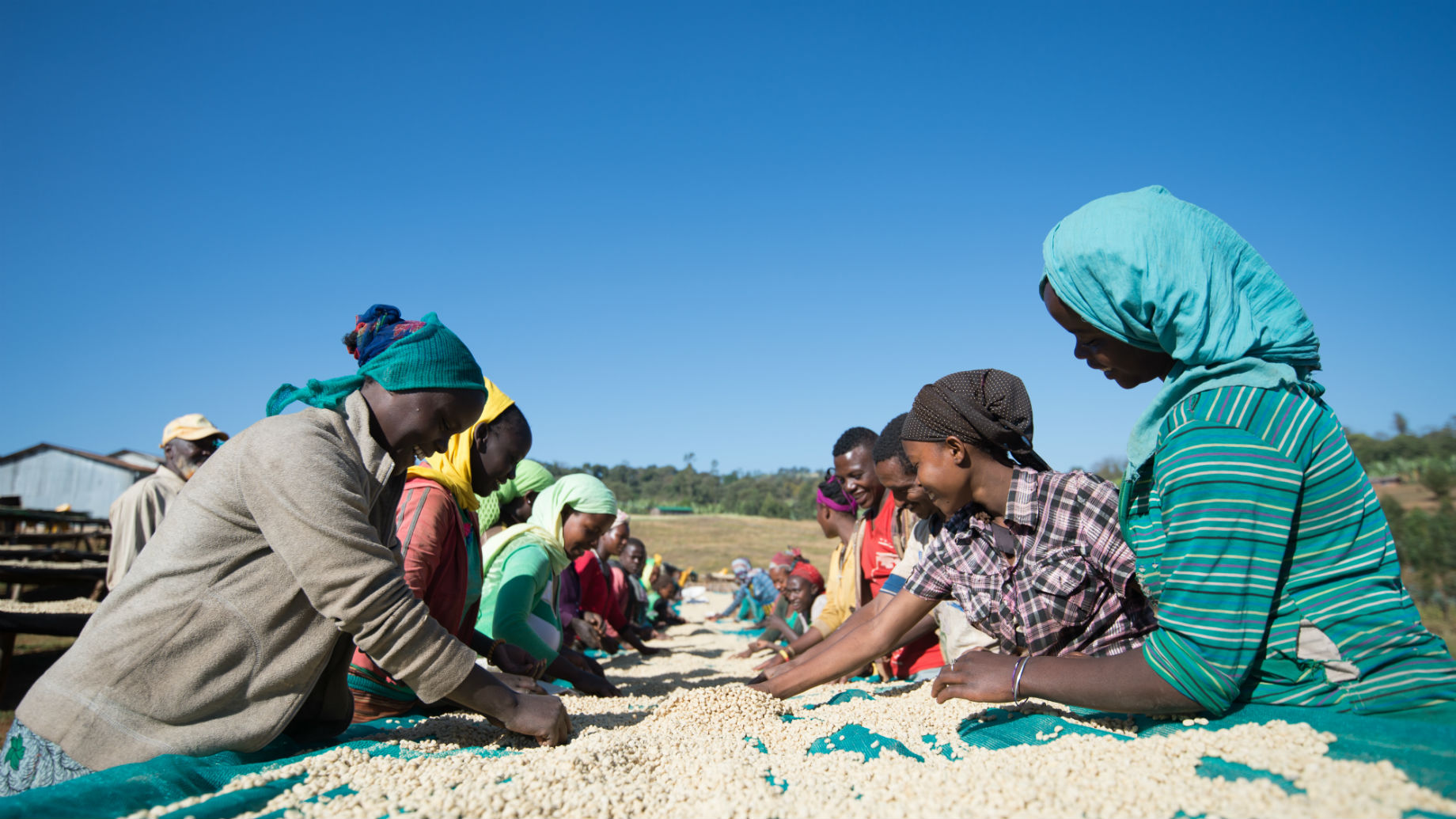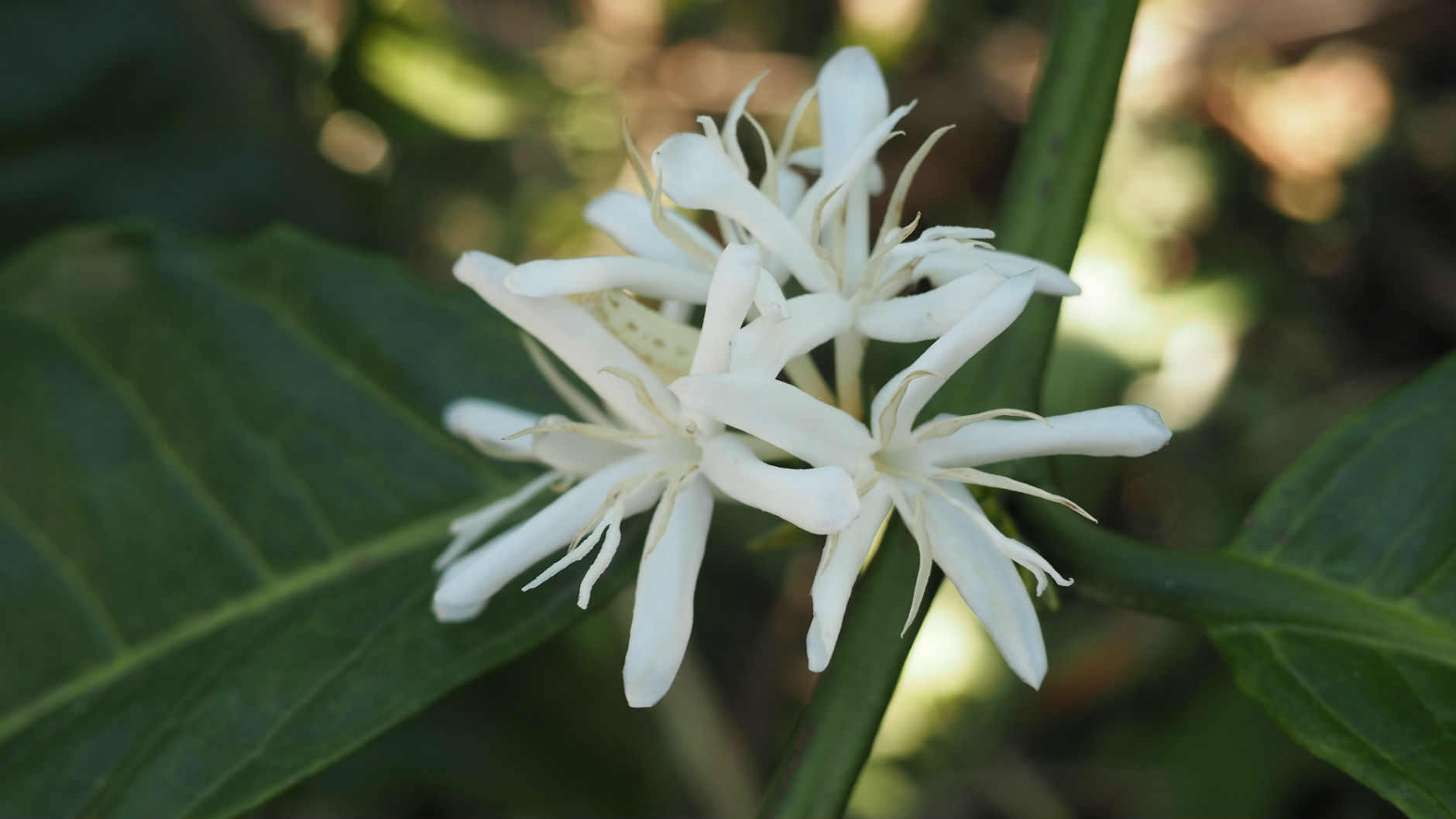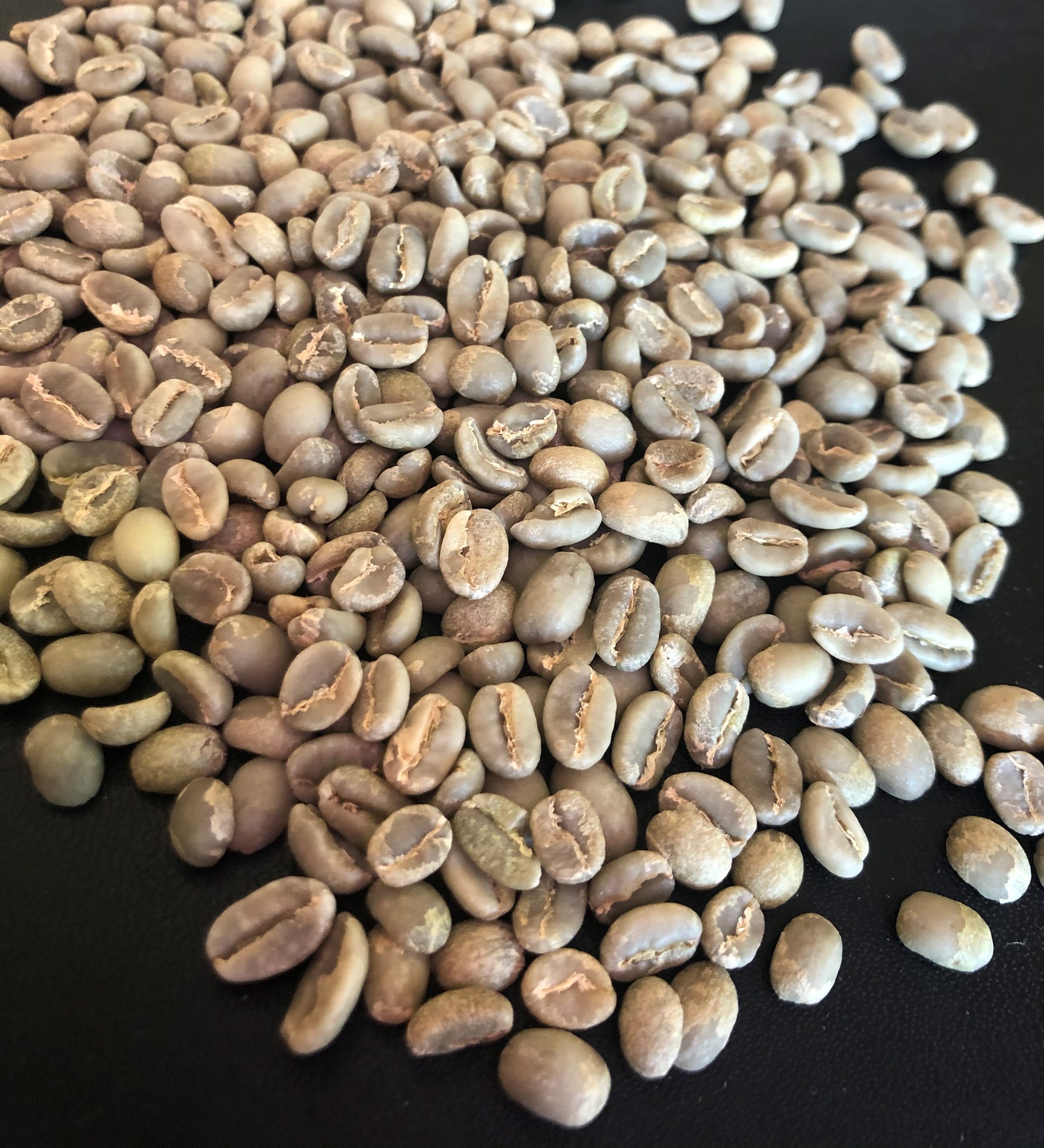Ethiopia Tomme Feku Jiberil Double Washed Crown Jewel
Boxes 0
Warehouses Oakland
Out of stock
intro
Intro by Chris Kornman
As Royal is one of the highest volume importers of Ethiopian coffee, my usually sharp memory for names and coffees from the past is occasionally challenged by the sheer number of incredible coffees that flood the warehouse each summer.
When I was cupping through arrival samples recently this coffee would absolutely not be ignored on the cupping table. Dank and hoppy on the aroma, the cup itself oozes kiwi and rosemary, raspberry lemonade and jasmine. It’s got this big buttery body and an aftertaste like a July afternoon in a rose garden. It is unsubtle in all of the best ways.
As it happens, when I started down my usual paths of uncovering who grows the coffee, it turns out we fell madly in love with this Guji coffee two years ago. The coffee is processed at a private washing station in Uraga. Feku Jiberil is the owner of this facility in the town of Tomme in the Guji zone, where he works with a group of about 600 smallholders to process their coffees traditionally with a long underwater fermentation (36-48 hours) and post wash soak.
Guji is part of Ethiopia’s largest region, Oromia, and it shares a border with the Gedeo Zone – home to Yirgacheffe town – and offers many similar cup characteristics with their own regional idiosyncrasies. Tomme town is part of the Uraga woreda, which borders the Gedeb & Wole woredas of Gedeo on the west, and Hambela Wamena to the south.
green
Green Analysis by Chris Kornman
Stereotypical southern Ethiopian green specs here, including very high density, low-to-moderate moisture, and very small screen size. The coffee will undoubtedly crave heat and the green (under good storage conditions) should stay fresh for months and months.
While there are certainly true heirloom coffees grown in much of Ethiopia, it’s also true that a relatively small number of highly controlled cultivars — both lab-crafted hybrids and selected landraces — are often the main components of specialty coffees throughout the nation. The selections have not been denoted here for us, but it’s fair to assume they are similar stock to the greater southern coffee regions, hearty and well adapted for cultivation in this, one of the world’s most coveted terroirs.
taste
ikawa
Ikawa Analysis by Chris Kornman
We’ve updated our V2 Ikawa Pro machines with the latest Firmware version (24) and run on “closed loop” setting. Our roasters underwent full service in October of 2018 which included replacement heating elements and an updated PT 1000 temperature sensor, and were recalibrated in September 2019.
A versatile coffee with a lot of range, you’ll likely find that as long as you supply sufficient heat and follow best practices you’re likely to strike something delicious. You’ll also find a fairly malleable flavor profile, depending on how you like to style your washed Ethiopian coffee experience.
My preferred roasts are usually quick and to the point, and spend as little time in Maillard as possible for these ultra-dense washed coffees. Pick up the pace as the color changes, back off as it cracks, coast for a few fleeting and aromatic moments, and you’re home free.
My shortest roast (blue), consequently was my favorite. Fragrant and unsubtle, the coffee kicked up a hell of an aroma and filled its promise in the slurp. Jasmine and citrus are here of course, but it’s the light raspberry note and heady herbal flavors paired with some tropical greenish fruits… let’s say kiwi and horned melon… that really grabbed my attention. I’ll go back for seconds and thirds, and lift a glass from the cupping table and take it to my desk, please and thanks.
The longest roast (yellow) produced a near-equally enjoyable experience, with plenty of similar flavors, albeit subtler and a little darker. The finish was clean and super sweet, and it cooled very nicely after initially seeming just a hint tart and hollow.
The Maillard +30 (red) roast, as promised, spent the most time of all three in color development. The signature result is increased viscosity at the expense of acidic complexity, but the coffee was still delightfully sweet if a bit mellow. It also gave off an absolutely intoxicating fragrance.
You can download the profile to your Ikawa Pro app here:
Roast 1: Crown Standard SR 1.0
Roast 2: Crown Maillard +30 SR 1.0
Roast 3: Crown 7m SR Low AF
probatino
Roast Analysis by Candice Madison
Hot, fast and delectable. Nope, not that – roasting this week’s Crown Jewel! In this case, the coffee in question is an absolutely stellar example of a washed Ethiopian coffee and, honestly, one that I could drink all day, every day. This lot hails from the town of Tomme and is produced by Feku Jiberil is exceptional. Cupping this arrival was akin to being slapped by a bunch of chrysanthemums – soft, gorgeous, and in your face! This is not a new coffee to The Crown, or even myself, but it is one that pleases, as if for the first time, year on year.
Knowing that I love my coffee’s full of origin character, I decided on a short roast, emphasising stage one of the curve to bring out as many of the fruit and florals from this complex origin’s known flavor profiles. I dropped the 400g batch in at 360F at 2 on the gas dial (minimum). I then let the coffee take the time it needed, instead of pushing to 3.5 (the new maximum on the Probatino, due to gas regulator tweaking), I kept the gas at 3, after the turning point. This tactic meant that the coffee spent about 47% of the total roast time in stage 2.
My plan was to greedily try and get all I could from both stage 1 and stage 2, and finish it off with a light post-crack development achieved by a truncated stage 3. I managed to achieve this by stepping down on the gas (to 2.5 on the dial) at around 10 degrees F before first crack, at around 380F, and then again to gas dial 2 just as first crack began to roll at 393F.
Wanting the coffee to have a short but complete post crack development period, and as the batch was rising at a slow and steady rate, I dropped the coffee into the cooling tray at just under a minute after first crack, resulting in a healthy 14% development ratio. The smell of this coffee, from the green beans, as it progressed through the roast and as it dropped into the tray below had me hopping on foot to foot for 8 hours to pass, just so I could cup it.
Wow. Just wow. Really – what a result. I feel obligated to say that this coffee would taste simply delicious over a wide variety of roast profiles/styles, and that I had the easiest time roasting these impeccably sourced and prepared beans. That being said, being able to roast a coffee as close to the desired flavor profile is not always a guarantee, but I was able to, and the result was even more than I could have hoped for.
Chris describes this offering from Guji as dank, and he. is. not. wrong! The explosion of floral notes started on the dry fragrance as I ground each cup. The aroma of the crust was a symphony of sugar browning notes, subdued florals and an array of different fruits. In the cup, a black tea backdrop, highlighted notes of jasmine and tea rose being buoyed up by a complex sweetness. I could taste notes of caramel, brown sugar and bright panela, and berries. The acidity was mandarin forward, with other citric notes of kumquat and Meyer lemon. The body was unusually syrupy – a perfect foil for all of the notes to sit comfortably in. How should you drink this coffee? Quickly – because I doubt it will stick around (the others don’t know, but I pinched the rest of the roast from the lab to drink all to myself – don’t say a word!!).
behmor
Behmor Analysis by Evan Gilman
Unless otherwise noted, I follow a set standard of operations for all my Behmor roasts. Generally, I’ll use the 1lb setting, manual mode (P5), full power, and high drum speed until crack. Read my original post and stats here.
I honestly do wait all year for Ethiopian arrival season. The wait is over, and we’re well on our way to exploring the absolute best (in my humble opinion) of what coffee has to offer the world. Only our second washed Ethiopian coffee of the year, this one is a regular on our menu that I recall from years past.
In homage to the bright and lively flavors washed Ethiopian coffees are known for, I decided to push this coffee as mightily as I could with the Behmor 1600 Plus, and didn’t stop for first crack either. With 100% heat application all the way through my roast, my only adjustment was to open the door of the roaster for 40 seconds at first crack to abate some heat and smoke. After 1:05 of development, I hit cool, and that was that. Crack was very loud and consistent, and you won’t get fooled by any errant pops. At 11:45 on the timer, the roast was finished.
The cup here was laden with heavy purple floral aromas, abundant malic acidity, chocolaty sweetness, and thick mouthfeel. Like Chris says above, I was ready to just take this cup back to my desk to add some more shine to my day.
I would personally drink this coffee any way it came to me, but check the brew parameters below for some suggestions!
brew
Brew Analysis by Evan Gilman
Just a word of praise to start off with: It is going to be very hard to mess this coffee up. If you’re into the heavy sweetness and deep florals an Ethiopian coffee can offer, this one is just for you. On the other side of things, if you’re looking for huge berry notes or zesty lemon acidity, hold tight! We’ve got treats in store for you.
Anyhow, on to the main course. I started this coffee off with my normal parameters: a 1:16 Chemex brew using grind 22 on the Baratza Virtuoso, 150g pulse pours, 200F water, and rapt attention. My first brew went well from the technical side of things, though it took quite a long time to drain through at 5:40. The resulting cup was more than 19% extracted, but the flavors just weren’t as clear as I would have liked. Thick, sweet, and floral.. But the most dominant note I got from it was concord grape. I wanted more nuance.
I decided to go for not only a coarser grind, but a faster pour as well. With 200g pulse pours and a grind setting of 24, I had nearly forgotten that sometimes these dense coffees actually need a finer grind to pour through more quickly. My resulting brew was just slightly less extracted, and took a full 6:00 to pour through. The cup, however, was delicious. Distinct caramel sweetness, thick milk chocolate, and florals that resolved in jasmine came through more clearly. Still, I wanted more.
To that effect, I decided to up my brew ratio to 1:17 while maintaining the 200g pulse pours, and this time adding agitation during preinfusion and draw down. This was the cup for me. At a lower extraction percentage yet, clean peach, lemon bar, and cantaloupe came through clearly. The juicy malic acid notes really started to come through.
Put in a little work, and this coffee is going to reward you in amazing ways. I would suggest this coffee for any brew method at all, but of course my favorite is the crisp and clean filter drip. Don’t be shy of espresso, however; those caramel and milk chocolate notes are going to make a fabulous espresso with sweetness that will rest on your palate for days. Highly recommended.





